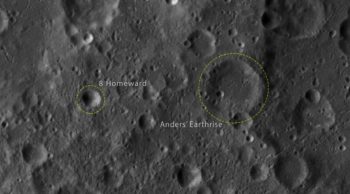
The newly named craters are visible in the foreground of the iconic Earthrise color photograph taken by astronaut William Anders. It depicts the moment that the shiny blue Earth came back into view as the spacecraft emerged out of the dark from behind the grey and barren Moon. This is arguably the most famous picture taken by Apollo 8. It became iconic and has been credited with starting the environmental movement.
Credit: NASA/IAU
That crater-pocked Moon has two new geological features: Anders’ Earthrise and 8 Homeward.
The Working Group for Planetary System Nomenclature of the International Astronomical Union has today officially approved the naming of two craters on the Moon to commemorate the 50th anniversary of the Apollo 8 mission.
Since the Moon is tidally locked to the Earth — it always has the same side facing the Earth — the Earth will never appear to rise above the surface to someone standing on the lunar far side.

The Working Group for Planetary System Nomenclature of the International Astronomical Union has officially approved the naming of two craters on the Moon to commemorate the 50th anniversary of the Apollo 8 mission. The names are Anders’ Earthrise and 8 Homeward. These two craters are marked here.
Credit: IAU
Orbiting around the Moon, however, gave the Apollo 8 astronauts, Frank Borman, James Lovell, and William Anders a stunning view, before they safely returned home to Earth.
The Apollo 8 mission took place from 21 to 27 December 1968.
After completing 10 orbits around the Moon on Christmas Eve, broadcasting images back to Earth and giving live television transmissions, the crew returned to Earth and landed in the Pacific Ocean.


Fantastic artwork! This is the kind of information to be shared on the internet. Feel bad for on Google without extended positioning this article higher! Come on more than as well as discuss with the web site. Thank you Means)